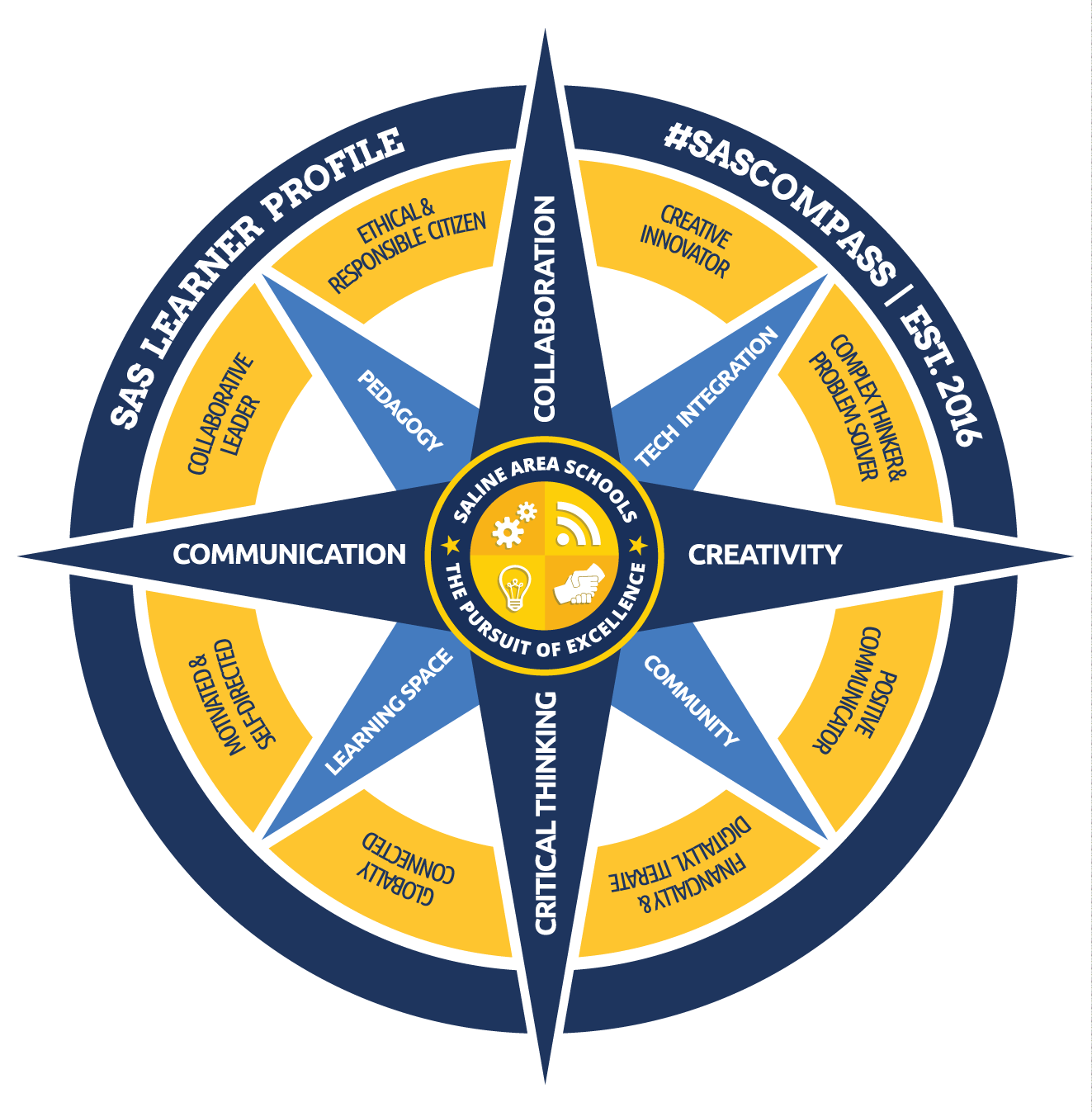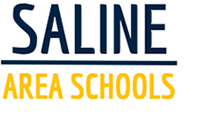Saline Area Schools 4 Cs
The 4 Cs consist of communication, collaboration, creativity and critical thinking. The dark blue compass points identify 4 primary skills that we want all of our Saline Area Schools' students to demonstrate proficiency in by the time they graduate.
Communication
Students are learning to communicate clearly for a range of purposes and environments, listen effectively to comprehend meaning, articulate thoughts through oral, non-verbal and written communication, use media and technologies effectively, and know how to judge their effectiveness and impact.
Creativity & Innovation
Students are learning to think creatively by using their curiosity and imagination to elaborate, refine, analyze and evaluate ideas. Students are learning to work creatively with others by being open and responsive to new ideas and perspectives. Students view failure as an opportunity to learn, show inventiveness in their work and develop, implement and communicate new ideas with others.
Collaboration
Students are learning to collaborate with others by working respectfully and effectively in diverse groups, being flexible and willing to work together towards a common goal and accept shared responsibility for collaborative work and value the unique contributions of each member.
Critical Thinking & Problem Solving
Students are learning to reason effectively, use systems thinking, make judgments and decisions based off of analysis, synthesis, evaluation, and reflection, ask questions that lead to better solutions and solve problems in conventional and creative ways.
4 Cs Rubrics
Rubrics are used as a tool for teachers as they prepare rigorous learning experiences and assess how students are growing in their application of these four important traits.
Classroom Environment
To support the 4 Cs work, it is important to create the proper conditions for students to be successful. The light blue compass points represent the importance of building "Community" to understand the 4 Cs, creating appropriate "Learning Spaces" that support the 4 Cs, adjusting the instructional "Pedagogy" to teach the 4 Cs, and providing proper "Tech Integration" to leverage the tools needing to support 4 Cs learning.
Pedagogy
Teaching is an art and a science that requires strong methods and content to be delivered in a way that is engaging and effective. This process relies on:
- Curricula and content that are standards-aligned and instructional practices that are evidence-based
- Opportunities for students to gain new knowledge in a safe environment and to practice with meaningful feedback
- A setting that is supportive of students overall mental and physical well-being.
- Reliable ways to assess progress formally and informally in order to drive instruction and maximize each student’s potential
- Empowering students to be active, self-directed learners, motivated to access knowledge and develop new ideas.
Learning Spaces
In order to achieve an environment where deeper, authentic and more engaging learning is taking place, the traditional classroom layout is redefined in Next-Gen classrooms. In supporting the 4Cs of collaboration, communication, critical thinking and creativity, our learning spaces have been redesigned to include:
- Open learning spaces (moveable walls for co-teaching)
- Learning zones
- Collaboration stations
- Non-traditional desks/tables
- No "front" of the classroom
- Variety of table and seating heights: low level, traditional and bar height
- Variety of comfortable seating types: conversation chairs, traditional chairs and soft seating
- Flexible furniture that can be placed in a variety of configurations
Community
Our students’ community is comprised of Saline Area Schools and the surrounding community, such as the City of Saline and Washtenaw County. Partnerships within our community help connect our classroom work to our greater world. Partnerships we already have:
- Foundation for Saline Area Schools
- Saline Recreation Center
- Booster and Alumni Groups
- Parent Teacher Organizations
- Community Based Work Sites (Michigan Ave)
- Food Gatherers
- Saline Social Services
- Kiwanis
- Senior Center
- Linden Square/Brecon Village
- Police and Fire Departments
Tech Integration
Next-Gen classrooms support a mixed and multi-media approach so that students are able to access digital content anytime, anywhere, on any device and at any pace. The tools currently supporting the teaching and learning process in Next-Gen classrooms include:
- iPad / Chromebooks (Y5-5)
- Newline and Promethean
- BYOD Policy
- ScreenBeam
- Multiple TVs
- Enterprise wireless and business class internet
- Google Drive/Docs, Gmail and web filter
Student Attributes
The student attributes are designed to integrate 8 essential skills to support 4 Cs instruction. These yellow visuals surrounding the compass points support a more detailed look at the specific actions that we want our students to take in order to be successful in implementing the 4 Cs and future life endeavors.
Collaborative Leader
Students are demonstrating collaborative leadership when they work in pairs or groups to discuss an issue, seek varying perspectives to resolve a problem, and/or create a product.
- Students will:
- Students will work collaboratively in pairs, small groups, and whole groups.
- Students will respect each other's ideas, work, and property.
- Students will identify evidence of varying perspectives relating to an issue.
- Students will explain the reasoning for varying perspectives relating to an issue.
Ethical and Responsible Citizen
Students are ethical and responsible citizens when they see beyond themselves to the needs of others, contribute to their community, promote equity, take responsibility for the environment, and demonstrate respect, empathy and compassion.
- Students will:
- Students will take responsibility for their own actions and behaviors.
- Students will take a role in caring for their classroom, school, community, and global environment.
- Students will positively contribute to the lives of others and demonstrate an understanding of equity.
- Students will demonstrate empathy for differences in their peers and their communities.
Creative Innovator
Students are demonstrating creativity when they define and develop and/or revise innovative ideas with attention to originality.
- Students will:
- Students will be able to brainstorm new ideas to solve problems.
- Students will ask questions and respectfully consider everyone’s perspective.
- Students will use ingenuity and imagination when shaping new ideas.
- Students will demonstrate the confidence to take risks when solving problems.
Complex Thinker and Problem Solver
Students are complex thinkers and problem solvers when they systematically go beyond knowledge reproduction to analyze, synthesize, evaluate, or organize information in ways that generate new and deeper understandings.
- Students will:
- Students will will generate and use questions to expand their thinking.
- Students will analyze the pros and cons of potential outcomes to determine the best solution.
- Students will implement a variety of approaches to solve problems.
- Students will accept and learn from failure.
Positive Communicator
Students are communicating skillfully when they connect and share ideas and choose the right medium(s) to express their thoughts. Students are communicating successfully when they resolve controversy and conflict through positive negotiation.
- Students will:
- Students will communicate effectively through a variety of tools (digital, verbal, written) specific to their intended audience.
- Students will communicate their viewpoints respectfully and appreciate the viewpoints of others.
- Students will resolve controversy and conflict through positive communication strategies.
- Students will engage in actively listening in order to grow ideas.
Financially and Digitally Literate
Students are financially literate when they can identify and connect personal financial planning and manage both internal and external financial challenges.
Students are digitally literate when they work fluidly between technological platforms/mediums and move from consumers to producers of knowledge and content.
- Students will:
- Students will consider the implications of their financial decisions.
- Students will evaluate the cause and effect of the use of local and global resources.
- Students will seek trustworthy information to actively enhance their learning.
- Students will make responsible choices regarding their digital footprint.
Globally Connected
Students are globally connected when they demonstrate their understanding of the complexities of cultures and global issues, see viewpoints beyond their own, and positively impact and connect to the world around them.
- Students will:
- Students will understand multiple viewpoints based on current and past social issues.
- Students will apply multiple viewpoints to explore the similarities and differences of many cultures.
- Students will analyze how actions have impacted their community, country, and world.
- Students will demonstrate respect, empathy, and appreciation when working with a global audience.
Motivated and Self-directed
Students are motivated and self-directed when they choose an element of the content, product, and/or process for their learning and when they recognize purpose enabling them to set, monitor, and take ownership of their own learning goals.
- Students will:
- Students will set learning goals and initiate learning.
- Students will self-assess, self-advocate, and reflect.
- Students will persevere through learning tasks.
- Students will utilize mindfulness practices.










